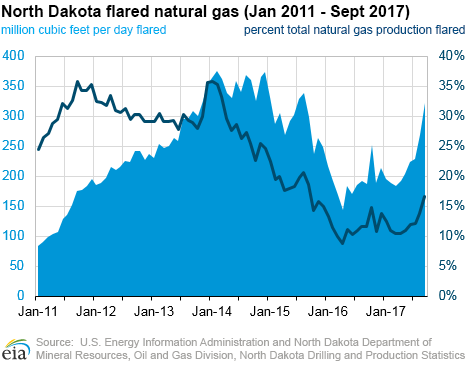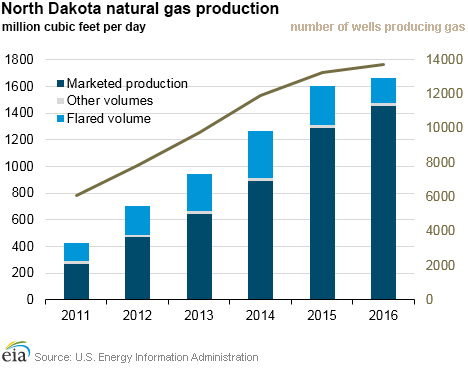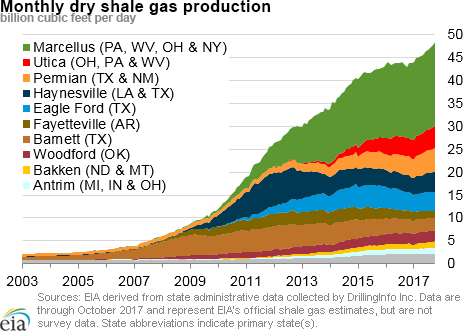Updated December 1 to correct missing text.
In the News:
North Dakota natural gas flaring increases in recent months
North Dakota flared 17% of the natural gas it produced in September 2017, a 3 percentage point increase in flared volumes from the previous month, despite a 3% natural gas production decrease in September according to North Dakota’s Department of Mineral Resources. The data released in September 2017 show that this is the highest reported percentage of flared gas since September 2015, although the share of natural gas flared in a month in North Dakota has been as high as 36% in January 2014. More than 90% of the natural gas flared in September came from the Bakken formation, and six force majeure (unavoidable interruption) events contributed to the September increase in flaring. These events included one-time situations such as compressors being offline at one plant, a pipeline shutdown, and road restrictions preventing liquids transportation.
Annual flared gas volumes in North Dakota steadily increased between 2011 and 2014 as the state’s oil production grew. During 2015, the volume of flared natural gas dropped by 18% to 292 million cubic feet per day (MMcf/d). The volume dropped an additional 34% in 2016, to 192 MMcf/d. During the period from January to September 2017, the flared natural gas volume was 223 MMcf/d, 22% higher than last year’s volume for the same nine months.
Despite the increase in flared natural gas during the first nine months of 2017, marketed natural gas production in North Dakota totaled 1,534 MMcf/d, about 5% higher than last year’s marketed production for the same period. (Note: EIA estimated North Dakota’s marketed production for September 2017 by applying the growth rate between the sold volume values from the North Dakota Department of Mineral Resources between August and September to EIA’s reported marketed production for August 2017.)
North Dakota has worked to reduce its natural gas flaring, and in 2015, the North Dakota Industrial Commission set natural gas capture goals for each operator: 85% of the gas captured from November 1, 2016 through October 31, 2018; 88% captured from November 1, 2018 through October 31, 2020; and 91% beginning on November 1, 2020. Particular provisions of the policy define how compliance with these goals and any related penalties will be determined.
To comply with North Dakota’s gas capture standards, gas processing and pipeline capacity has been built. Additional investments are being made to improve current infrastructure in North Dakota, such as the expansion of natural gas processing capacity at the Wild Basin Gas Plant to 280 MMcf/d.
Natural gas flaring frequently occurs at oil-rich production sites with associated natural gas deposits and at natural gas processing plants. For a limited time, flaring provides a means for handling the associated natural gas, especially when processing and transportation capacities are unavailable. For example, flaring can be used when testing new wells and before connecting to a take-away pipeline.
Overview:
(For the Week Ending Wednesday, November 29, 2017)
- Natural gas spot prices rose at most locations this report week (Wednesday, November 22, to Wednesday, November 29, 2017). The Henry Hub spot price rose from $2.93 per million British thermal units (MMBtu) last Wednesday to $3.06/MMBtu yesterday.
- At the New York Mercantile Exchange (Nymex), the December 2017 contract expired Tuesday at $3.074/MMBtu. The January 2018 contract price increased to $3.179/MMBtu, up 12¢ Wednesday to Wednesday.
- Net withdrawals from working gas totaled 33 billion cubic feet (Bcf) for the week ending November 24, 2017. Working natural gas stocks are 3,693 Bcf, which is 8% lower than the year-ago level and 3% lower than the five-year (2012–16) average for this week.
- The natural gas plant liquids composite price at Mont Belvieu, Texas, remained flat at $8.30/MMBtu. The price of ethane, butane, and isobutane fell by 1%, 2%, and 2%, respectively. The price of propane rose by 1%. The price of natural gasoline remained flat week over week.
- According to Baker Hughes, for the period ending Wednesday, November 22, the natural gas rig count decreased by 1 to 176. The number of oil-directed rigs rose by 9 to 747. The total rig count increased by 8, and it now stands at 923.
Prices/Supply/Demand:
Prices increase across the country. This report week (Wednesday, November 22, to Wednesday, November 29, 2017), the Henry Hub spot price rose 13¢ from $2.93/MMBtu to $3.06/MMBtu. Henry Hub prices hit a weekly low on Monday of $2.82/MMBtu, after temperatures across the country warmed over the Thanksgiving holiday and weekend. Many price points had a similar Monday low, with prices then increasing as colder weather was forecast for next week.
At the Chicago Citygate, prices increased 16¢ from $2.83/MMBtu to $2.99/MMBtu over the report week, with a low of $2.70/MMBtu on Monday. Prices at PG&E Citygate in Northern California rose 22¢, from $2.97/MMBtu to $3.19/MMBtu over the report week. The price at SoCal Citygate increased $2.23, from $3.03/MMBtu to $5.26/MMBtu over the report week, as Southern California continues to face pipeline and storage constraints.
Northeast prices mixed. At the Algonquin Citygate, which serves Boston-area consumers, prices went down 19¢ from $3.26/MMBtu to $3.07/MMBtu over the report week. At the Transcontinental Pipeline Zone 6 trading point for New York, prices increased 4¢ from $3.00/MMBtu last Wednesday to $3.04/MMBtu yesterday, with a low of $2.75/MMBtu on Monday.
Tennessee Zone 4 Marcellus spot prices increased 10¢ from $2.30/MMBtu to $2.40/MMBtu over the report week, reaching a low of $2.17/MMBtu on Monday. Prices at Dominion South in northwest Pennsylvania rose 14¢ from $2.42/MMBtu to $2.56/MMBtu over the report week, after also reaching a low of $2.29/MMBtu on Monday.
Nymex prices increase. At the Nymex, the December 2017 contract expired Tuesday at $3.074/MMBtu, up 11¢ from last Wednesday, as forecasts predicted a colder December. The January 2018 contract increased to $3.179/MMBtu, up 12¢ over the report week. The price of the 12-month strip averaging January 2018 through December 2018 futures contracts climbed 4¢ to $3.039/MMBtu.
Supply rises. According to data from PointLogic Energy, the average total supply of natural gas rose by 1% compared with the previous report week. Dry natural gas production grew by 1% compared with the previous report week. Average net imports from Canada decreased by 1% from the previous week.
Demand falls. Total U.S. consumption of natural gas fell by 6% compared with the previous report week, according to data from PointLogic Energy. Natural gas consumed for power generation declined by 5% week over week, while industrial sector consumption decreased by 1% week over week. In the residential and commercial sectors, consumption declined by 10% as temperatures warmed across the country. Natural gas exports to Mexico decreased by 1%.
U.S. liquefied natural gas (LNG) exports increase week over week. Four LNG vessels (LNG-carrying capacity of 14.9 Bcf) departed the Sabine Pass liquefaction facility last week (Thursday to Wednesday), and two tankers (LNG-carrying capacity of 7.1 Bcf) were loading at the terminal on Wednesday. November is likely to set a new record with 23 LNG cargoes loaded (an estimated 81 Bcf of LNG exports), exceeding the previous record set in October of 22 loaded cargoes.
Storage:
Net withdrawals fall below five-year average during storage week. Net withdrawals from storage totaled 33 Bcf for the week ending November 24, compared with the five-year (2012–16) average net withdrawal of 47 Bcf and last year's net withdrawals of 43 Bcf during the same week. Relatively milder temperatures resulted in decreased natural gas consumption, primarily in the residential/commercial and electric power sectors, and the smaller-than-average net withdrawals. Working gas stocks ended the week with 3,693 Bcf, which is 107 Bcf lower than the five-year average and 309 Bcf lower than last year at this time. Most of the deficit to the five-year average can be attributed to the South Central and Pacific regions, where working gas stocks were 38 Bcf and 45 Bcf below their five-year average levels, respectively. Working gas levels in the East and Midwest regions—where natural gas is an important fuel for space and water heating—were 24 Bcf below and 4 Bcf above the five-year average, respectively.
Net withdrawals were also below the five-year average in most regions. The Midwest region reported net withdrawals from storage above its five-year average. Withdrawals in the Midwest totaled 22 Bcf, compared with its five-year average of 19 Bcf. Net withdrawals in the East region totaled 15 Bcf, just 1 Bcf lower than its five-year average for the week. Most other regions reported net injections. Notably, the South Central salt region reported net injections totaling 8 Bcf, compared with the five-year average net withdrawal of 1 Bcf for the report week. These net injections more than offset the net withdrawals of 5 Bcf reported by nonsalt facilities in the region. As a result, net injections in the South Central region totaled 3 Bcf, compared with the five-year average net withdrawal of 7 Bcf for the week.
The January 2018 futures price traded at a premium compared with the current spot price. During the most recent storage week, the average natural gas spot price at the Henry Hub was $3.02/MMBtu, while the Nymex futures price of natural gas for delivery in January 2018 averaged $3.13/MMBtu, a difference of 11¢. The premium was 40¢ for the same week a year ago. The average natural gas spot price at the Henry Hub was 1¢ lower than the front-month futures price at the Nymex. A year ago, the spot price was 26¢ lower than the front-month contract price.
Reported net implied flows into storage were close to analysts’ expectations. According to the Desk survey of natural gas analysts, estimates of net withdrawals from working natural gas storage ranged from 28 Bcf to 51 Bcf with a median of 37 Bcf. Prices for the futures contract for December delivery declined somewhat to $3.07/MMBtu at the release of the Weekly Natural Gas Storage Report (WNGSR), with 565 contracts traded. Prices remained close to that level in subsequent trading.
Temperatures were close to normal during the storage week in most of the Lower 48 states. Temperatures in the Lower 48 states averaged 46 degrees Fahrenheit (°F), 2°F higher than normal and 1°F lower than last year at this time. Temperatures were within 2°F of the normal in most regions east of the Rockies in the Lower 48 states. However, temperatures west of the Rockies were considerably warmer than normal, with the Mountain and Pacific Census divisions averaging 47°F and 59°F, 9°F and 7°F higher than the normal, respectively.
See also:
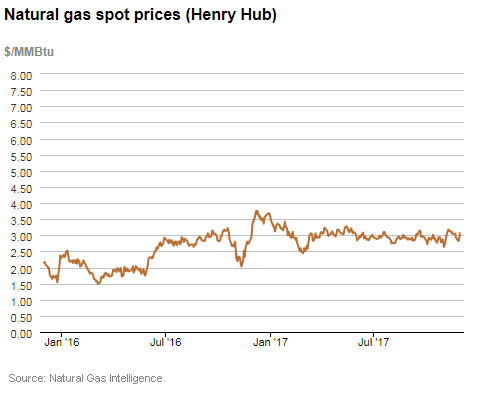
| Spot Prices ($/MMBtu) | Thu, 16-Nov |
Fri, 17-Nov |
Mon, 20-Nov |
Tue, 21-Nov |
Wed, 22-Nov |
|---|---|---|---|---|---|
| Henry Hub | 3.05 |
3.05 |
3.05 |
3.05 |
2.93 |
| New York | 3.08 |
3.12 |
2.96 |
3.06 |
3.00 |
| Chicago | 3.03 |
2.99 |
3.03 |
3.05 |
2.83 |
| Cal. Comp. Avg.* | 3.03 |
2.99 |
2.93 |
2.97 |
2.88 |
| Futures ($/MMBtu) | |||||
| December Contract | 3.053 |
3.097 |
3.047 |
3.017 |
2.968 |
| January Contract | 3.153 |
3.191 |
3.140 |
3.110 |
3.059 |
| *Avg. of NGI's reported prices for: Malin, PG&E Citygate, and Southern California Border Avg. | |||||
| Source: NGI's Daily Gas Price Index | |||||
| Spot Prices ($/MMBtu) | Thu, 23-Nov |
Fri, 24-Nov |
Mon, 27-Nov |
Tue, 28-Nov |
Wed, 29-Nov |
|---|---|---|---|---|---|
| Henry Hub | Holiday |
Closed |
2.82 |
2.91 |
3.06 |
| New York | Holiday |
Closed |
2.75 |
2.97 |
3.04 |
| Chicago | Holiday |
Closed |
2.70 |
2.85 |
2.99 |
| Cal. Comp. Avg.* | Holiday |
Closed |
2.80 |
2.84 |
2.82 |
| Futures ($/MMBtu) | |||||
| December Contract | Holiday |
2.813 |
2.928 |
3.074 |
Expired |
| January Contract | Holiday |
2.916 |
3.017 |
3.128 |
3.179 |
| February Contract | Holiday |
2.929 |
3.023 |
3.131 |
3.179 |
| *Avg. of NGI's reported prices for: Malin, PG&E Citygate, and Southern California Border Avg. | |||||
| Source: NGI's Daily Gas Price Index | |||||
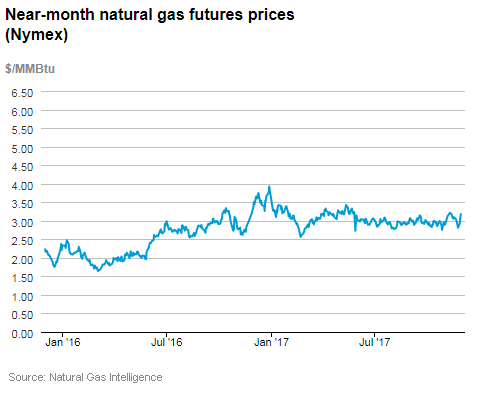
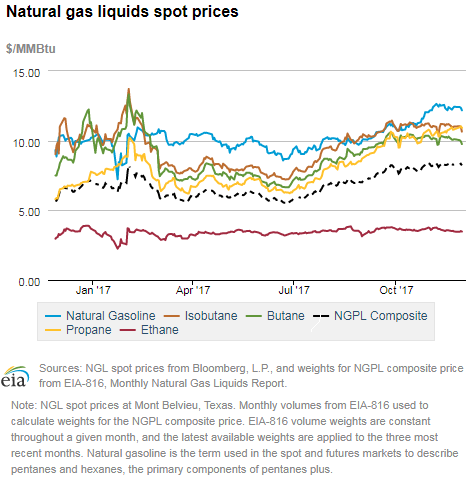
| U.S. natural gas supply - Gas Week: (11/23/17 - 11/29/17) | |||
|---|---|---|---|
Average daily values (Bcf/d): |
|||
this week |
last week |
last year |
|
| Marketed production | 85.2 |
84.3 |
79.6 |
| Dry production | 76.7 |
75.8 |
71.2 |
| Net Canada imports | 5.1 |
5.2 |
5.4 |
| LNG pipeline deliveries | 0.2 |
0.2 |
0.3 |
| Total supply | 81.9 |
81.2 |
76.8 |
|
Source: OPIS PointLogic Energy, an IHS Company | |||
| U.S. natural gas consumption - Gas Week: (11/23/17 - 11/29/17) | |||
|---|---|---|---|
Average daily values (Bcf/d): |
|||
this week |
last week |
last year |
|
| U.S. consumption | 67.0 |
71.2 |
69.2 |
| Power | 20.8 |
22.0 |
20.7 |
| Industrial | 21.4 |
21.6 |
21.6 |
| Residential/commercial | 24.8 |
27.6 |
26.9 |
| Mexico exports | 4.5 |
4.5 |
4.0 |
| Pipeline fuel use/losses | 6.3 |
6.7 |
6.5 |
| LNG pipeline receipts | 3.0 |
3.0 |
1.4 |
| Total demand | 80.8 |
85.4 |
81.0 |
|
Source: OPIS PointLogic Energy, an IHS Company | |||
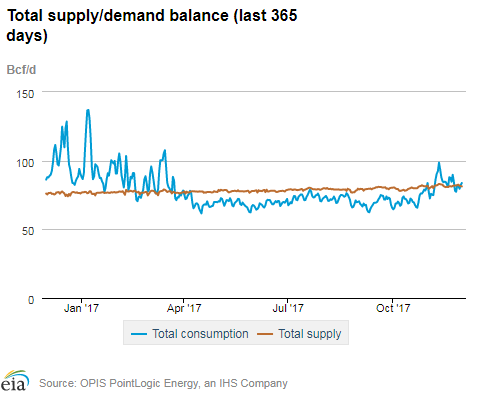
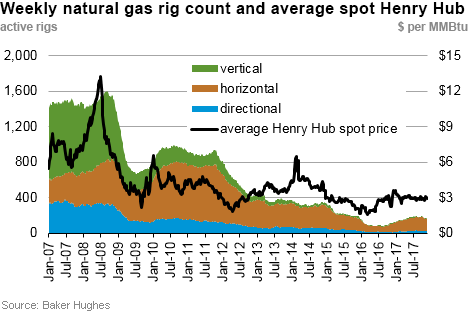
| Rigs | |||
|---|---|---|---|
Fri, November 24, 2017 |
Change from |
||
last week |
last year |
||
| Oil rigs | 747 |
1.2% |
57.6% |
| Natural gas rigs | 176 |
-0.6% |
49.2% |
| Note: Excludes any miscellaneous rigs | |||
| Rig numbers by type | |||
|---|---|---|---|
Fri, November 24, 2017 |
Change from |
||
last week |
last year |
||
| Vertical | 66 |
4.8% |
0.0% |
| Horizontal | 786 |
1.3% |
65.5% |
| Directional | 71 |
-6.6% |
36.5% |
| Source: Baker Hughes Inc. | |||
| Working gas in underground storage | ||||
|---|---|---|---|---|
Stocks billion cubic feet (Bcf) |
||||
| Region | 2017-11-24 |
2017-11-17 |
change |
|
| East | 876 |
891 |
-15 |
|
| Midwest | 1,068 |
1,090 |
-22 |
|
| Mountain | 221 |
220 |
1 |
|
| Pacific | 314 |
314 |
0 |
|
| South Central | 1,214 |
1,211 |
3 |
|
| Total | 3,693 |
3,726 |
-33 |
|
| Source: U.S. Energy Information Administration | ||||
| Working gas in underground storage | |||||
|---|---|---|---|---|---|
Historical comparisons |
|||||
Year ago (11/24/16) |
5-year average (2012-2016) |
||||
| Region | Stocks (Bcf) |
% change |
Stocks (Bcf) |
% change |
|
| East | 915 |
-4.3 |
900 |
-2.7 |
|
| Midwest | 1,133 |
-5.7 |
1,072 |
-0.4 |
|
| Mountain | 258 |
-14.3 |
217 |
1.8 |
|
| Pacific | 328 |
-4.3 |
359 |
-12.5 |
|
| South Central | 1,367 |
-11.2 |
1,252 |
-3.0 |
|
| Total | 4,002 |
-7.7 |
3,800 |
-2.8 |
|
| Source: U.S. Energy Information Administration | |||||
| Temperature – heating & cooling degree days (week ending Nov 23) | ||||||||
|---|---|---|---|---|---|---|---|---|
HDD deviation from: |
CDD deviation from: |
|||||||
| Region | HDD Current |
normal |
last year |
CDD Current |
normal |
last year |
||
| New England | 172 |
-2 |
24 |
0 |
0 |
0 |
||
| Middle Atlantic | 172 |
7 |
26 |
0 |
0 |
0 |
||
| E N Central | 192 |
3 |
30 |
0 |
0 |
0 |
||
| W N Central | 195 |
-18 |
25 |
0 |
0 |
0 |
||
| South Atlantic | 117 |
5 |
7 |
11 |
0 |
5 |
||
| E S Central | 128 |
13 |
22 |
1 |
0 |
1 |
||
| W S Central | 66 |
-14 |
9 |
12 |
7 |
0 |
||
| Mountain | 129 |
-57 |
-13 |
3 |
3 |
2 |
||
| Pacific | 47 |
-47 |
-38 |
2 |
1 |
2 |
||
| United States | 136 |
-12 |
9 |
4 |
1 |
1 |
||
|
Note: HDD = heating degree day; CDD = cooling degree day Source: National Oceanic and Atmospheric Administration | ||||||||
Average temperature (°F)
7-Day Mean ending Nov 23, 2017
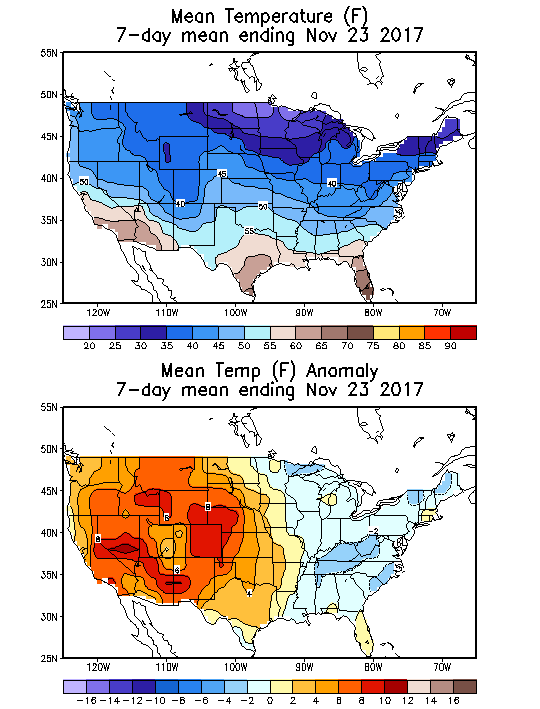
Source: NOAA National Weather Service
Deviation between average and normal (°F)
7-Day Mean ending Nov 23, 2017

Source: NOAA National Weather Service

